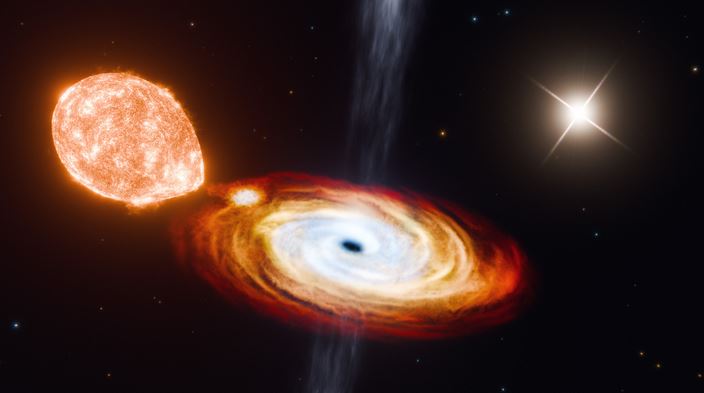Context:
In a groundbreaking discovery, scientists have discovered a “black hole triple” system in space for the first time.
About the Triple System & Its Formation
The black hole triple system named V404 Cygni, comprises a black hole at its centre, and two stars circling it.
Situated in the constellation of Cygnus, the system is located about 8,000 light years away from Earth.
- One light year is the distance light travels in a year, which is about 9.5 trillion kilometres.
The discovery of this black hole triple challenges existing theories of black hole formation, as most previously known black holes are part of binary systems consisting of a black hole and a secondary object (such as a star or another black hole).
However, the black hole triple not only has one star which orbits the black hole about every 6.5 days, but also a more far-off star which orbits it every 70,000 years.
Formation:
- Researchers suggest that V404 Cygni’s black hole may have formed through a “direct collapse” rather than a supernova (which typically kicks away outer stars in the explosion).
- In this process, known as a “failed supernova”, the dying star’s core collapses inwards without an explosive release of outer layers.
- This “gentle” implosion allows nearby stars to remain gravitationally bound to the black hole, as no force expels them outward.
Significance of the Discovery
- New Formation Model: The discovery suggests that some black holes may form through direct collapse, altering the accepted view that most black holes form exclusively through supernovae.
- Potential for Hidden Triple Systems: The black hole’s consumption of the nearer star suggests that some already discovered binary systems could have initially been triple systems at some point, with the black hole later devouring one of its members.
- Astronomical Insights: This finding deepens our understanding of celestial evolution, revealing that failed supernovae may play a more prominent role in the creation of black holes and possibly other cosmic structures.
What is a Black Hole?
- A black hole is a region in space where the gravitational pull is so intense that nothing, not even light, can escape.
- Typically, black holes form when massive stars collapse at the end of their lives in a supernova explosion.
Types of Black Holes:
- Stellar-Mass Black Holes: These are formed from collapsing stars which have their masses around 20 times that of Sun’s mass.
- Supermassive Black Holes: Almost every large galaxy, including our Milky Way, has a supermassive black hole at its centre. They have hundreds of thousands to billions of times the Sun’s mass.
- Intermediate-Mass Black Holes: They are black holes with a mass that is between 100 and 100,000 times that of the Sun.
Also Read:
‘

